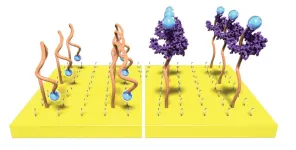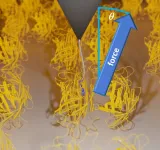(Press-News.org) Molecules in our body send faint biochemical signals when health issues arise
New technology boosts these signals by 1,000 times
New approach paves way for sensing signals in real-time in the body without sending blood or saliva samples to a lab
EVANSTON, Ill. — The molecules in our bodies are in constant communication. Some of these molecules provide a biochemical fingerprint that could indicate how a wound is healing, whether or not a cancer treatment is working or that a virus has invaded the body. If we could sense these signals in real time with high sensitivity, then we might be able to recognize health problems faster and even monitor disease as it progresses.
Now Northwestern University researchers have developed a new technology that makes it easier to eavesdrop on our body’s inner conversations.
While the body’s chemical signals are incredibly faint — making them difficult to detect and analyze — the researchers have developed a new method that boosts signals by more than 1,000 times. Transistors, the building block of electronics, can boost weak signals to provide an amplified output. The new approach makes signals easier to detect without complex and bulky electronics.
By enabling amplification of weak biochemical signals, the new approach brings modern medicine one step closer to real-time, on-site diagnostics and disease monitoring.
The research was published Saturday (March 24) in the journal Nature Communications.
“If we could reliably measure biochemical signals in the body, we could incorporate those sensors into wearable technologies or implants that have a small footprint, less burden and don’t require expensive electronics,” said Northwestern’s Jonathan Rivnay, the study’s senior author. “But extracting high-quality signals has remained a challenge. With limited power and space inside the body, you need to find ways to amplify those signals.”
Rivnay is a professor of biomedical engineering at Northwestern’s McCormick School of Engineering. Xudong Ji, a post-doctoral researcher in Rivnay’s laboratory, is the paper’s first author.
While they communicate vital information packed with potential to guide diagnoses and treatment, many chemical sensors produce weak signals. In fact, health care professionals often cannot decipher these signals without removing a sample (blood, sweat, saliva) and running it through high-tech laboratory equipment. Usually, this equipment is expensive and perhaps even located off-site. And results can take an excruciatingly long time to return.
Rivnay’s team, however, aims to sense and amplify these hidden signals without ever leaving the body.
Other researchers have explored electrochemical sensors for biosensing using aptamers, which are single strands of DNA engineered to bind to specific targets. After successfully binding to a target of interest, aptamers act like an electronic switch, folding into a new structure that triggers an electrochemical signal. But with aptamers alone, the signals are often weak and highly susceptible to noise and distortion if not tested under ideal and well-controlled conditions.
To bypass this issue, Rivnay’s team equipped an amplifying component onto a traditional electrode-based sensor and developed an electrochemical transistor-based sensor with new architecture that can sense and amplify the weak biochemical signal. In this new device, the electrode is used to sense a signal, but the nearby transistor is dedicated to amplifying the signal. The researchers also incorporated a built-in, thin-film reference electrode to make the amplified signals more stable and reliable.
“We combine the power of the transistor for local amplification with the referencing you get from well-established electrochemical methods,” Ji said. “It’s the best of both worlds because we’re able to stably measure the aptamer binding and amplify it on site.”
To validate the new technology, Rivnay’s team turned to a common cytokine, a type of signaling protein, that regulates immune response and is implicated in tissue repair and regeneration. By measuring the concentration of certain cytokines near a wound, researchers can assess how quickly a wound is healing, if there is a new infection or whether or not other medical interventions are required.
In a series of experiments, Rivnay and his team were able to amplify the cytokines’ signal by three-to-four orders of magnitude compared with traditional electrode-based aptamer sensing methods. Although the technology performed well in experiments to sense cytokine signaling, Rivnay says it should be able to amplify signals from any molecule or chemical, including antibodies, hormones or drugs, where the detection scheme uses electrochemical reporters.
“This approach is broadly applicable and doesn’t have a specific use case,” Rivnay said. “The big vision is to implement our concept into implantable biosensors or wearable devices that can both sense a problem and then respond it.”
The study, “Organic electrochemical transistors as on-site signal amplifier for electrochemical aptamer-based sensing,” was supported by the Defense Advanced Research Projects Agency (grant number D20AC00002).
END
Half as many children in the United States were diagnosed with asthma in the first year of the COVID-19 pandemic compared to previous years, and Rutgers researchers think fewer colds may be part of the reason.
In a new Rutgers study, published in Respiratory Research, researchers examined the rates of new asthma diagnoses in a large commercial insurance claims database during the first year of the pandemic compared with rates of new diagnoses during the previous three years.
Using the Health Core Integrated Research ...
A common anesthesia drug could be beneficial in reducing pressure inside the skull of children with traumatic brain injuries (TBI), according to a study published in Critical Care Medicine.
Ketamine, a drug that has been used for anesthesia since the 1970s, has traditionally been avoided for patients with TBI due to early studies suggesting that it could raise the pressure inside of the skull, known as intracranial pressure (ICP).
More recent studies have suggested otherwise, said lead author Michael Wolf, MD, assistant professor of Pediatrics and Neurological ...
Photos
For the first time, researchers have pinpointed a date when elite Mongol Empire people were drinking yak milk, according to a study co-led by a University of Michigan researcher.
By analyzing proteins found within ancient dental calculus, an international team of researchers provides direct evidence for consumption of milk from multiple ruminants, including yak. In addition, they discovered milk and blood proteins associated with both horses and ruminants. The team's results are published in Communication Biology.
The study presents novel protein findings from an elite Mongol Era cemetery ...
URBANA, Ill. – For tiny salamanders squirming skin-to-soil, big-picture weather patterns may seem as far away as outer space. But for decades, scientists have mostly relied on free-air temperature data at large spatial scales to predict future salamander distributions under climate change. The outlook was dire for the mini ecosystem engineers, suggesting near elimination of habitat in crucial areas.
Now, University of Illinois researchers are tuning into the microclimates that really matter to the imperiled amphibians and forecasting a somewhat more hopeful future.
“The ...
BOSTON-- Humans are colonized with thousands of bacterial strains. Researchers are now focused on genetically modifying such bacteria to enhance their intrinsic therapeutic properties.
One goal is to develop smart microbes that release therapeutic payloads at sites of disease, thus maintaining therapeutic efficacy while limiting many of the side effects that can be associated with the systemic administration of conventional drugs.
Investigators at Massachusetts General Hospital (MGH), a founding member of Mass General Brigham (MGB), have engineered a strain of the probiotic Escherichia ...
An interdisciplinary research team of the Institutes of Physical Chemistry and Physics of the University of Freiburg and the Max Planck Institute of Biophysics in Frankfurt-am-Main has discovered a new, direction-dependent friction in proteins called anisotropic friction. “Until now, nobody had observed that friction in biomolecules was dependent on direction,” says physicist Dr. Steffen Wolf of the University of Freiburg. The results have been published as cover story in the scientific journal “Nano Letters.”
Experiments on model complex of protein-ligands
Proteins constitute the microscopic machinery of cells. They perform work during their functional cycles. Accordingly, ...
When Hurricane Florence made landfall on North Carolina’s coast in 2018, it brought record rainfall causing catastrophic flooding and damages to communities across the eastern portion of the state.
Estimating the financial impacts of household flooding is complex because direct damages often snowball into other financial risks, like a decrease in property value or loss of equity. Generally, post-disaster damage assessments focus on insured and uninsured losses, but these numbers do not account for the secondary impacts to households, lenders, local governments and other stakeholders who may also share in the financial consequences if a property owner defaults ...
The Forex market, also known as the foreign exchange market or simply Forex (short for "foreign exchange"), is a decentralized global market where various currencies are traded. It is the largest financial market in the world, with a daily trading volume exceeding $6 trillion. The primary purpose of the Forex market is to facilitate international trade and investment by allowing businesses, governments, and individuals to convert one currency into another.
Researchers are deploying the latest mapping techniques to identify the most important suburban habitat for North America’s largest woodpecker.
University of Cincinnati doctoral student Ruijia Hu said wildlife habitat in congested places like southwest Ohio is becoming increasingly fragmented as forests give way to new construction. Eventually, this could spell trouble to an animal with specific habitat needs like Ohio’s pileated woodpecker.
Pileated woodpeckers are crow-sized birds with colorful red crests and striking white facial stripes. They are found in forests from British Columbia to Florida. They have the ...
A new study by Cedars-Sinai investigators describes how ChatGPT, an artificial intelligence (AI) chatbot, may help improve health outcomes for patients with cirrhosis and liver cancer by providing easy-to-understand information about basic knowledge, lifestyle and treatments for these conditions.
The findings, published in the peer-reviewed journal Clinical and Molecular Hepatology, highlights the AI system’s potential to play a role in clinical practice.
“Patients with cirrhosis and/or liver cancer and their caregivers often have unmet needs and insufficient knowledge about managing and preventing complications of their disease,” ...




